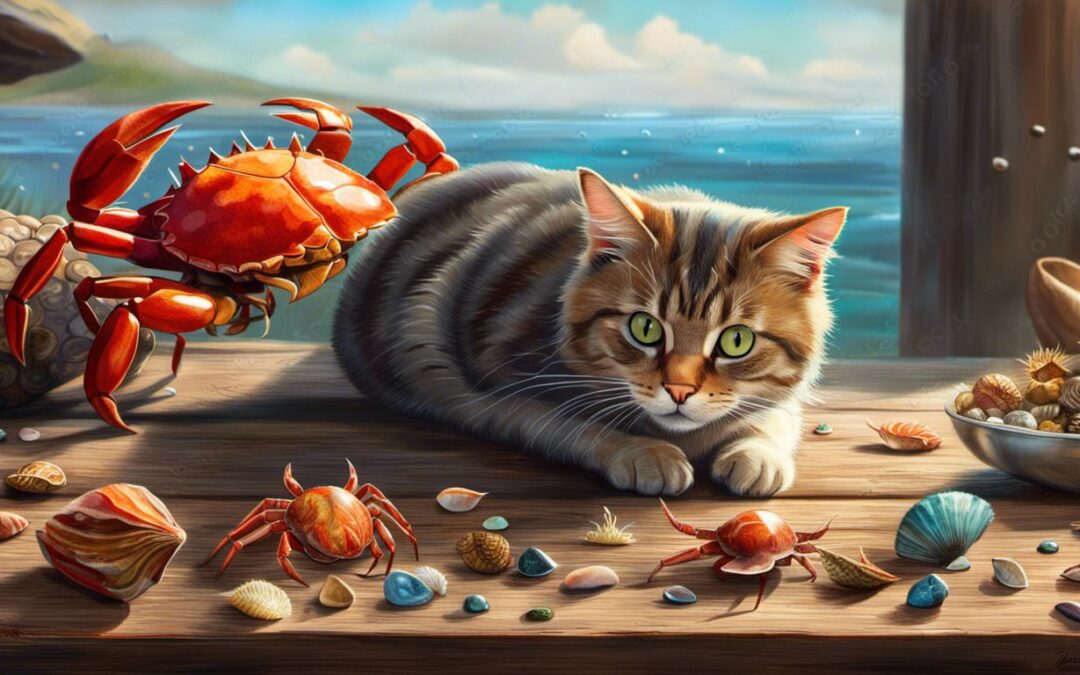Have you ever wondered if the delicious seafood dish you’re enjoying could be shared with your furry friend? While crab is a rich source of protein and essential vitamins, it’s not always safe for cats.
This blog post will guide you through the complexities of giving your kitty crab, including nutritional benefits, potential hazards, and tips for feeding them safely. Let’s dive into what makes crab a possible delicacy or danger to your beloved feline!
Key Takeaways
- Cats can eat crab, but it’s important to consider the nutritional benefits and potential hazards before feeding it to them.
- Crab meat is rich in protein, low in fat, and contains omega-3 fats, vitamin B12, and zinc, which can provide various health benefits for cats.
- Safety concerns include the risk of foodborne illnesses from raw or undercooked crab meat and the potential for choking on small bones or shell fragments.
- Cooked crab is generally safer for cats than raw crab. Other cat – friendly options include crab shells (for dental health), crab sticks (in moderation), imitation crab (with caution), and canned crab (specifically made for cats).
Can Cats Eat Crab?
Cats can eat crab, but there are important considerations to keep in mind.
Nutrition facts
Crab meat has been widely recognized for its high nutritional content that can benefit cats.
| Nutrient | Amount per 100g |
|---|---|
| Protein | 19g |
| Fat | 1.2g |
| Omega-3 fats | 0.3g |
| Vitamin B12 | 9mcg |
| Zinc | 4.7mg |
Crab meat is rich in protein which helps in the growth and repair of your cat’s body. It has low fat content that makes it a healthy choice. Omega-3 fats can support a shiny coat, reduce inflammation and support your cat’s immune system. Vitamin B12 supports the health of your cat’s nerves and blood cells and prevents anemia. Zinc is crucial for your cat’s immune system function and metabolism. Therefore, crabs can provide a host of benefits to your cat.
Safety concerns
Feeding your cat crab can come with some safety concerns. One main concern is the risk of foodborne illnesses, such as salmonella or listeria, which can be present in raw or undercooked crab meat.
Another concern is the potential for choking on small bones or shell fragments if you’re feeding your cat fresh crab that hasn’t been properly prepared. Additionally, some cats may have allergies to seafood, including crab, so it’s important to watch for any signs of an adverse reaction after feeding them this treat.
Taking precautions and following safe preparation methods will help ensure that your feline friend can safely enjoy a taste of crab without any issues.
Cooked vs. raw crab
Cooked crab is generally safer for cats to eat than raw crab. Cooking the crab helps to kill any potential bacteria or parasites that may be present in the meat. Raw crab can pose a risk of foodborne illnesses, so it’s best to avoid feeding it to your cat.
When preparing crab for your feline friend, make sure it is properly cooked and free from any seasoning or additives that could be harmful. Remember, moderation is key when introducing new foods into your cat’s diet, including cooked crab.
Other Types of Crab for Cats
There are several other types of crab that cats can safely eat, including crab shells, crab sticks, imitation crab, and canned crab.
Crab shells
Crab shells can be a great source of entertainment and dental health for cats. Cats love to play with crab shells, batting them around and chewing on them. Chewing on the hard shells helps to remove plaque from their teeth, promoting good oral hygiene.
Just make sure to only give your cat clean and cooked crab shells without any seasonings or additives that may be harmful to them. It’s important to supervise your cat while they’re playing with crab shells to prevent any accidents or injuries.
Crab sticks
Crab sticks can be a popular choice for cat owners looking to give their feline friends a seafood treat. These processed snacks are made from fish, usually pollock or cod, and flavored with crab extract.
While they may mimic the taste of crab, it’s important to note that crab sticks aren’t actually made from real crab meat. They are highly processed and may contain additional additives and preservatives that may not be suitable for all cats.
As with any new food introduction, it’s best to feed crab sticks in moderation and monitor your cat for any adverse reactions.
If you decide to give your cat crab sticks as an occasional treat, make sure to read the ingredients list carefully. Look out for any potential allergens such as artificial flavors or colors that could trigger sensitivities in your pet.
It’s also important to remember that while some cats enjoy the taste of seafood treats like crab sticks, others may not be interested or have dietary restrictions that prevent them from indulging.
Imitation crab
Imitation crab is a popular seafood alternative for humans, but can cats eat it too? While imitation crab may be made from fish and other ingredients that are generally safe for cats to consume, it’s important to note that it often contains additives and preservatives that might not be the best for their health.
These additives could potentially cause digestive issues or allergies in some cats. Additionally, imitation crab is highly processed and lacks the nutritional value of fresh seafood.
It’s best to stick with cat-friendly options when treating your feline friend.
Canned crab
Canned crab can be a convenient and tasty option to feed your cat. It is important to choose canned crab that is specifically made for cats and does not contain any added spices, seasoning, or preservatives.
This ensures that the crab is safe for your cat to eat. Canned crab can provide protein and essential nutrients for your feline friend in a delicious way. Remember to always check the label and consult with your veterinarian before adding canned crab or any new food to your cat’s diet.
Feeding Cats Crab Safely
To feed cats crab safely, it is important to ensure moderation in their diet and properly prepare the crab before offering it to them. In addition, be cautious of the sodium intake as excessive amounts can be harmful to cats.
Moderation
Feeding your cat crab can be a tasty treat, but it’s important to do so in moderation. While cats can enjoy the nutritional benefits of crab, too much of it can cause digestive issues or upset stomachs.
It’s best to offer crab as an occasional treat rather than a regular part of their diet. By feeding crab in moderation, you can ensure that your cat gets to savor the flavor without any negative side effects.
To practice moderation when feeding your cat crab, start by offering small portions and observing how they react. Watch for any signs of discomfort or unusual behavior after eating.
Preparation
Preparing crab for your cat requires a few simple steps to ensure it’s safe and enjoyable for them. Here’s how you can prepare crab for your feline friend:
- Cook the crab thoroughly to eliminate any potential bacteria or parasites that could harm your cat.
- Remove the shell and any hard parts, as they can pose a choking hazard.
- Shred the crab meat into small, bite – sized pieces that are easy for your cat to eat and digest.
- Serve the prepared crab in moderation as an occasional treat rather than a regular part of their diet.
Sodium intake
Excessive sodium intake can be harmful to cats, just like it is for humans. While small amounts of sodium are necessary for a cat’s overall health, too much can lead to complications such as high blood pressure and kidney problems.
It’s important to monitor your cat’s sodium intake and avoid feeding them foods that are high in salt. Instead, opt for low-sodium options when preparing their meals or choosing treats.
By being mindful of your cat’s sodium intake, you can help ensure they stay healthy and happy.
Conclusion
In conclusion, cats can eat crab as an occasional treat, but it should be offered in moderation and prepared properly. Cooked crab is generally safe for cats to consume, but the shells should always be removed.
It’s important to keep in mind your cat’s individual dietary needs and consult with a veterinarian before introducing any new foods into their diet.
FAQs
1. Can cats safely eat crab?
While it is generally safe for cats to consume small amounts of cooked crab meat, it is important to remove the shell and any seasoning or spices before feeding it to your cat. It is best to consult with a veterinarian before introducing new foods into your cat’s diet.
2. Are there any risks associated with cats eating crab?
There are a few potential risks associated with cats consuming crab. The shell can pose a choking hazard, and some seasonings or spices used in cooking may be harmful or irritating to cats’ digestive systems. Additionally, if the crab was not properly cooked or stored, it could contain bacteria that could make your cat sick.
3. How should I serve crab to my cat?
If you choose to feed your cat crab meat, ensure that it is fully cooked and free from shells or seasoning. You can shred the meat into small pieces and mix it with their regular food as an occasional treat. Monitor your cat for any signs of discomfort or allergic reactions after consumption.
4. What other seafood can I safely feed my cat?
Some other seafood options that are generally safe for cats include plain cooked fish like salmon or tuna (without added seasonings), shrimp (fully cooked without shells), and canned sardines in water (no added salt). As always, moderation is key, and consulting with a veterinarian about incorporating new foods into your pet’s diet is recommended.






